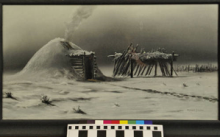Article
In the traditional construction of a hogan, the Diné dwelling house, a hole is cut in the roof in order to let smoke from the hearth fire below out of the room. The hole is usually placed off-center and aligned above the rock slab that serves as a hearth so that as the smoke rises it leaves the residence. In later, more modern hogans, flues that facilitated the removal of smoke directly from the rock-slab or adobe hearth have replaced the hole in the roof.
"Hogan," photograph, Hubbard Museum of the American West (1990.01.1707). New Mexico Centennial Project.
Manuscripts
A01 The Blessing Way (01-07) p. 44
A01 The Blessing Way (01-07) p. 45
A01 The Blessing Way (01-07) p. 75
A01 The Blessing Way (01-07) p. 93
A01 The Blessing Way (01-07) p. 95
A01 The Blessing Way (01-07) p. 117
References
Jett, Stephen C., and Virginia E. Spencer
1981 Navajo Architecture: Forms, History, Distributions. Tucson: University of Arizona
Press.

